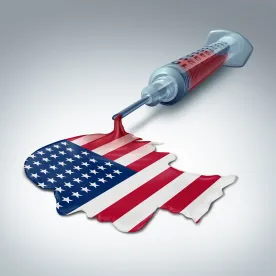On January 5, 2018, the Department of Labor (DOL or the “Department”) published a proposed rule to allow more Association Health Plans (AHPs) to be regulated as large group health plans. 83 Fed. Reg. 614 (Jan. 5, 2018) (to be codified at 29 C.F.R. pt. 2510). The proposed regulation was developed in response to President Trump’s October 12, 2017 Executive Order 13813, directing the executive branch to facilitate the purchase of insurance across state lines and, specifically, directing the DOL to “consider proposing regulations or revising guidance . . . to expand access to health coverage by allowing more employers to form AHPs.” The proposed regulation fulfills this charge by relaxing the Department’s existing interpretation of the conditions under which an association is considered the employer sponsor of a single multiple employer welfare arrangement under the Employee Retirement Income Security Act (ERISA). 83 Fed. Reg. at 626. An AHP that is a single multiple employer arrangement more easily qualifies as a plan offered in the large group market because it may aggregate employees of all employer members to determine the plan’s market. In some cases under the proposed rules, an AHP may be offered to employers in more than one State, even if the AHP is insured.
Background
Some small employers purchase health insurance for their employees through Multiple Employer Welfare Arrangements (MEWAs), which are subject to ERISA and state insurance laws. An AHP is a MEWA offered through an association or group, often organized by business or trade.
An AHP is generally held to the same federal standards as other group health plans under ERISA and the Public Health Service Act (PHSA), as amended by the Affordable Care Act (ACA). AHPs that are considered large group health plans are generally subject to less burdensome federal requirements. Under current law, the size of each individual employer participating in the AHP, rather than the size of the association itself, generally determines whether the employer’s coverage under the AHP is a small group health plan or a large group health plan. However, if the association is considered the sponsoring employer of a single AHP, all of the employees of the association’s employer members are aggregated for purposes of determining whether an AHP is a large group health plan subject to federal laws.
Under current law, it is difficult for an association to be considered the sponsor of a single AHP. The DOL requires a single AHP to be sponsored by a “bona fide” association that has “commonality of interest” with its members. The “commonality of interest” requirement can generally be met only in the rare cases that the association can demonstrate “[1] commonality of economic interests and [2] a genuine organizational relationship unrelated to the provision of benefits.” SeeAdvisory Opinion 2005-20A.
Proposed Changes to Regulations Governing Association Health Plans
The basic aim of the proposed regulation is to increase AHPs’ ability to qualify as large group health plans by making it easier for an association to meet the “commonality of interest” requirement. Instead of being required to show both “commonality of economic interest and a genuine economic interest unrelated to the provision of benefits,” under the proposed rules an association needs to show only that its members operate in the same trade or industry or are located in a common geographic area. This change effectively disposes of the requirement that an association exist for a purpose other than providing health care, and allows associations to offer group health plans across state lines within a single trade or industry.
The proposed regulation preserves the requirement that the employers comprising an association must be a “bona fide group or association.” To be considered a “bona fide group or association of employers capable of establishing a group health plan” under the proposed rule, an association of employers must: (1) exist, in whole or in part, to establish a group health plan for its members, (2) be made up of employers of at least one employee, (3) have a formal organizational structure, (4) be controlled by its employer members, (5) have a “commonality of interest,” (6) limit health coverage to employees and former employees, including their beneficiaries, of employer members, and (7) comply with nondiscrimination provisions. Additionally, a bona fide association cannot be a health insurance issuer, or be owned or controlled by a health insurance issuer.
The nondiscrimination provisions referenced in the “bona fide group or association” requirement build upon existing nondiscrimination provisions under the Health Insurance Portability and Accountability Act (HIPAA), as amended by the ACA. Under these nondiscrimination provisions, associations may not condition employer membership on any employee health factor, and they may not apply different eligibility rules or premium contribution rates to employers based on the health factors of an employer’s employees. For example, if an association sponsors a group health plan for all businesses in Lucky City, it cannot charge a business in Lucky City that employs several individuals with chronic illnesses more, on this basis, than other businesses in Lucky City.
Finally, the proposed regulation expands the availability of AHPs to working owners and their families, including sole proprietors, partners in a partnership, and other self-employed individuals, who generally (1) are not eligible for any subsidized group health plan maintained by any other employer of the individual or of the individual’s spouse and (2) either meet minimum work hour requirements or earn sufficient income from their trade or business. This expansion is achieved by allowing self-employed individuals to join AHPs as employers and simultaneously take advantage of the health benefits offered by AHPs as employees.
Potential Implications
If the rule is finalized, it could make AHPs more appealing for small employers, as the rule provides a pathway for small employers to potentially offer less expensive health coverage that is not required to cover all essential health benefits and may be rated solely on the association’s members instead of a statewide community population. Similarly, AHPs could become more attractive to large employers who wish to offer to a small group of employees a plan that is separate from the employer’s primary group health plan.
The Department represents that the proposed regulation “would not alter existing ERISA statutory provisions governing MEWAs,” and would not undermine the States’ authority to regulate AHPs. 83 Fed. Reg. at 625. Because the States share regulatory authority over MEWAs with the federal government, it is possible that some States would not relax state requirements related to essential health benefits for AHPs or would pass stricter requirements for AHPs if the proposed regulations become final.
Perhaps anticipating that States may take regulatory action in response to the proposed rule, the DOL raises the possibility of using ERISA section 514(b)(6)(B), which grants the Department authority to exempt from certain state insurance laws, on an individual or class basis, self-insured MEWAs that are employee benefit plans. The Department has never granted a section 514(b)(6)(B) exemption, but the Department suggests it might do so if it believes it would promote consumer choice across state lines. 83 Fed. Reg. at 625.





 />i
/>i

